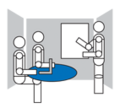Team space: A semi-enclosed work space for two to eight people; suitable for teamwork which demands frequent internal communication and a medium level of concentration
Cubicle: A semi-enclosed work space for one person, suitable for activities which demand medium concentration and medium interaction
Shared office: An enclosed work space for two or three people, suitable for semi-concentrated work and collaborative work in small groups
Team room: An enclosed work space for four to ten people; suitable for teamwork which may be confidential and demands frequent internal communication
Work lounge: A lounge-like work space for two to six people; suitable for short-term activities which demand collaboration and/or allow impromptu interaction
Touch down: An open work space for one person; suitable for short-term activities which require little concentration and low interaction
Meeting spaces
Meeting spaces in an office are typically used interactive processes, be it quick conversations or intensive brainstorms. There are six generic types of meeting space, each supporting different activities.Large meeting room: An enclosed meeting space for five to twelve people, suitable for formal interaction
Small meeting space: An open or semi-open meeting space for two to four persons; suitable for short, informal interaction
Brainstorm room: An enclosed meeting space for five to twelve people; suitable for brainstorming sessions and workshops
Meeting point: An open meeting point for two to four persons; suitable for ad hoc, informal meetings
Support spaces
Support spaces in an office are typically used for secondary activities such as filing documents or taking a break. There are twelve generic types of support space, each supporting different activities.Storage space: An open or enclosed support space for the storage of commonly used office supplies
Print and copy area: An open or enclosed support space with facilities for printing, scanning and copying
Pantry area: An open or enclosed support space where people can get coffee and tea as well as soft drinks and snacks
Break area: A semi-open or enclosed support space where employees can take a break from their work
Smoking room: An enclosed support space where employees can smoke a cigarette
Library: A semi-open or enclosed support space for reading of books, journals and magazines
Waiting area: An open or semi-open support space where visitors can be received and can wait for their appointment
Circulation space: Support space which is required for circulation on office floors, linking all major functions



























0 komentar:
Posting Komentar